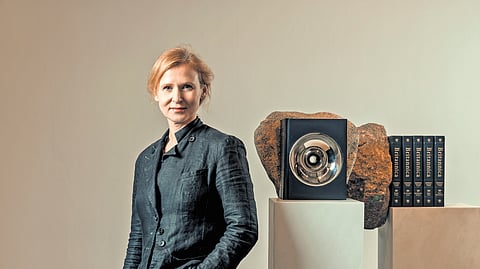

An intricate dance between perception and reality is how one would describe Berlin-based artist Alicja Kwade’s oeuvre. Presenting her first solo in India, titled Matter Moments, at the Nature Morte gallery in Delhi, the 45-year-old artist puts up expansive installations, sculptures and works on paper. Known for her deconstruction and reconstruction of everyday objects and natural materials, Kwade says, “For me, they have a certain symbolism or represent a specific interaction. They are simple to read and are interpreted in roughly the same way by everyone.”
At the centre of the exhibition stands a set of Encyclopedia Britannica books with a stone at one end and a stainless steel funnel on the other. It almost gives the impression of information passing from the books to an ear. Not surprisingly, the series of four works is titled Know-ledge. Hanging above these, are rocks suspended by gold-plated structures and wires, as if defying gravity. Transformator consists of a tree branch and its mirrored counterpart in patinated bronze. In the centre, lies a polished bronze sphere, serving as a mirror, transforming the surrounding. It quietly encourages viewers to go beyond everyday perception.
Elaborating on her love for these uncommon mediums, the artist says, “Mirrors are a challenging element, often over-interpreted and too smooth to use. I try to negate their traditional use, relegate their prominence, and transform them into tools for altering spaces and perspectives. I see them more as windows than mere reflective surfaces. When it comes to creating order and disappearance, I typically achieve this by placing mirrors symmetrically in rooms, playing with dual reflections and making objects themselves mirror images of each other.”
Mirrors and industrial materials often form a part of Kwade’s provocative works. In fact, the artist has also created a centrepiece at this year’s Sculpture Park exhibition at the 19th century Madhavendra Palace, Jaipur. The ambitious installation, Superposition, comprises steel frames and double-sided mirrors. Evoking plants and distant worlds are bronze chairs adorned with stone spheres. What stuns the viewers and also invites contemplation is the interplay between transparency and reflection.
The artist in also known to use technology to aid sculpting. She also makes use of mathematics formula, 3D programmes—scanning, printing and model-making—besides, logarithms. Critics have often said that her works explore the intersections between time, space, science, and philosophy. Kwade, however, disagrees.
“I believe, I’m engaging in one of the oldest human pursuits: I’m thinking about why things are the way they are, or at least how they appear, and exploring how others attempt to answer that question,” says the artist who indulges in large-scale installations. Any particular reason, you ask her and prompt comes the reply: “I started working more and more in public spaces, which often means outdoor settings. To be noticed outdoors, you need to go big.” She adds as an afterthought,
“My work has evolved significantly over time. As I’ve progressed, I’ve learned to believe in my decisions, trust my instincts and rely less on external guidance.
I would advise my younger self to spend even less time making decisions. It’s crucial to listen to yourself and trust your instincts rather than being swayed by others’ opinions or supposed strategies. Allowing oneself to be unsettled by external influences only hinders you.” So, how did she come to pursue a career in art? Kwade is almost scandalised by the question. “You don’t take up a career in art; you don’t pursue or aspire to it. You either are an artist or you’re not. If life is kind and doors open, then you’re allowed to do that, and you will not want to do anything other than just that. It will happen automatically. We are addicted to what we do, if we can,” she says, almost Zen-like.